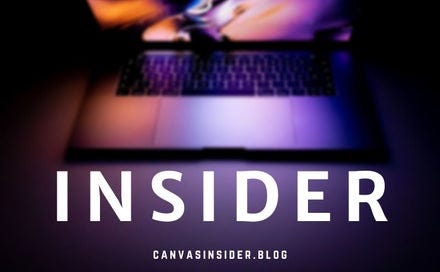In this audiogram, I wanted to share an exploration about tech support based on a moment in time from a Saturday afternoon at Costco.
Here is the transcript if you wish to read along, or not listen:
Hello Canvas Insiders! I wanted to share a story with you, a moment in time that happened to me recently that relates to my career in technology support. It's a moment in time that I unknowingly became someone whom I have referred to in the past in an allegory or a parable pertaining to my work in helping clients fix their computer problems. So check this out:
This past weekend I willingly chose to do something I normally, in my right mind, would NOT do. I went to Costco on a Saturday afternoon. I only had three things on my list: Vitamin C pills, Vitamin E pills, and multi-vitamin pills. Three bottles. No need for a big shopping cart, bang-bang see you later quick run into Costco. Now as most of us are aware of, there is no such thing as a quick visit to Costco. But let's get back to the story.
I park what seemed to be a quarter-mile away from the main entrance, which is the usual for a Saturday afternoon at our favorite behemoth warehouse location. Flashed my member card to the welcome person at the entrance, navigated myself through carts and carts of people wandering about the aisles, acquired my three vitamin pill bottles, and made my way to the checkout lines. Now here's where the story gets exciting.
With my 6-foot-3 height, I surveyed the 10-plus checkout stands with long lines of carts. Not for me. I saw on my right that there was four banks of self-checkout scanners. I noticed one was not being used. I made my way to the open self-checkout scanner space. I scanned my Costco membership card, beep, and scanned the three vitamin pil bottles, beep, beep, beep. I quickly tapped the Pay now button on the screen, and I sensed a person coming alongside of me and saying, "Sir, are you aware that there is a line for the self-checkout area?" As I pulled my payment card out of my jeans, I said, "Nope!" And the young man continued to lecture me, "For the future, we have a line for the self-checkout and there are people in line now."
Now, let's pause here for a moment, Canvas Insiders. one of my triggers in life is social embarrassment or social shame. Had it a lot while growing up as a shy, quiet loner without many friends in school, and I've done a lot of work to curate a universe where I am not likely to experience embarrassment or shame. In a split-second, I am now feeling embarrassed as my mind, my inner narrative, is telling me, as I'm tapping my credit card against the payment terminal, that there are a lot of people looking at me with derision, contempt, anger, you name it. I also have someone in a position of authority, so to speak, admonishing me for something I was unaware of. In my surveying of the Costco cattle herd of shopping cart, flatbed carts, and a ton of people gathered around the checkout areas, I did not see one instance of a sign for a checkout line, one orange traffic cone guiding shoppers to the way to check out. From my perspective, everyone was at least than 10-feet away from the self-checkout scanners, there was an open spot, and I took it.
Now here's my confession, Canvas Insiders. As I am replaying this moment in time back in my mindspace, I realize my triggered response of public embarrassment or shame, that split-second moment where my anxiety was telling me that that young staff person was going to make me cancel my order and go to the back of the line of shoppers, I did not respond nicely to his what-I-consider passive-aggressive informing me of established lines for checkout. As he said in a fairly parental-admonishing tone, "For the future, we have a line for the self-checkout and there are people in line now." I took my printed receipt, held it up to him and said, "three items, 42 seconds." And I left to exit the store. The young man then raised the stakes when he said, "Sir, I need to see your Costco member card," and as I'm walking away, I said, "Already scanned it. I wouldn't have been able to check out if I wasn't a member." and kept walking to the exit lines.
So I'm wagering you are assessing my behavior in that brief Saturday afternoon moment in time at a very busy shopping establishment as rude, combative, aggressive, and descriptors that if I were to say to them might flag this as explicit content. I understand you may feel that way. In hindsight I let my protective instincts prevail, and unfortunately, for me that means no-verbally aggressive behavior. But make no mistake, I have now been made aware of Costco's informal rules and management to "Effectively provide customer service" by loosely organizing line queues for customers to checkout and self-checkout. Knowing what I know now, if I repeated this behavior, in my inner narrative I would proclaim myself guilty as charged.
From other shoppers' perspectives, I would imagine that they viewed my "cutting in line" as cheating my way to a quick checkout. That whole cutting in line business was something that I learned in elementary school was not something you did. And as I watched "tougher" kids, or bullies, cut in front of other kids waiting in line and following the rules, my injustice streak got activated. That's not fair was usually my internal response. Perhaps you feel the same when someone cuts in line as you are being a good citizen and waiting your turn.
I share this past weekend's somewhat-embarrassing experience with you, my dear Canvas Insider, to illustrate a perspective about customer service, specifically technical support in higher education, of which I have 25+ years of experience. Your tech support is very busy attending to the large amount of requests for help coming from their clients. In order to help with the large amount of requests, upper management may have implemented a "ticketing system" or an email address for tech support needs. These systems allow the technical support professional to work through the list of requests as they are able to. It gives them the agency to discern which support needs are more urgent than others to resolve. It helps the tech support professional do their job the way they are most adept at. When a client places a phone call to the tech support professional, it is impossible for the tech to fix both issues at the same time. They have to stop what they're doing and "context switch" (Hi, Cal Newport!) to respond to your phone call. In some tech support situations, it's not a simple click a button and the problem is fixed, there might be 30 minutes of CSI-style forensic troubleshooting for the tech support professional to figure out what a client is talking about having only received a forwarded email from a student in which the client simply states, "please fix my student's issue." Stopping that cerebral focus on one issue, picking up a phone, and responding to a call from a client does three things to the tech support:
1 - They lose their focus on what they were working on
2 - They are now in a "pop quiz" mindset not knowing what their client is needing help with
3 - All others in the email inbox or ticketing queue are now waiting for the tech support professional to complete supporting the phone call and get back to the queue of support requests.
What is even more disabling to a professional tech support's inertia in performing their work effectively is when a client stops by their office unexpectedly with a need for their tech issue to be resolved right then and there. A professional tech support who has the ability to establish boundaries at work might respond to the client with, "I'm currently working on another customer's tech issue, would you wait a few minutes while I finish up?"
Some of you might find this a completely reasonable request, but ~some~ customers need their needs met now. Some would reply to a request for waiting with, "Oh, this will only take a minute." or "Oh, I just have a quick question, it won't take too long." And now the tech support professional is put in a tough situation: They either drop what they're doing to meet the in-person client's needs, which ~some~ management would require as a way to "provide outstanding customer service" which will result in a the tech spending number of minutes to resume the cerebral work on the issue they were working on before the interruption. I'm betting there's increased stress and/or anxiety involved in that "Where was I?" question the tech asks themself as they try to get back on track.
OR
The tech will re-iterate to the client that they are working on an issue right now, and please wait until the issue is resolved. And now we have a disappointed client who has to wait to get their needs met, something that, if management were made aware of, might make the tech support professional subject to "revisiting the department's standards for customer service."
I want to raise awareness to something, my conscientious and gracious Canvas Insiders. We are currently focusing on two, maybe three, people: the tech support professional, the client on the phone or in person, and perhaps management. We are overlooking a very important aspect. We are overlooking the line of people who sent emails or entered tickets for computer help. They are waiting in line for the tech support professional to help them with their needs. They are following the rules and not cutting in line to get to the tech support. These people who are not watching the tech support professional working are assuming they will get their issue resolved in an adequate timeframe. These emailers and ticket-makers don't see the person cutting in line of them by making a phone call or stopping by in person. I have a tough question for you to consider: if customers who are in the tech support professional's queue of service were made aware of you jumping ahead of them in line for help, just like I unknowingly did at Costco this past Saturday afternoon, do you think they would be okay with your choice to not email or fill out a ticket for help?
“Okay, Chris, what should I do to get my computer issues fixed, oh exalted guru of customer support?” Now now, let's not be too agitated about things. I'm sharing a perspective from the tech support professional. I am wagering management is not asking to learn about their tech support professional's perspective. I am also betting that the customers who are receiving support from their tech support professional (for free in many cases?) are not aware, nor do they even consider asking, about the tech's perspective. Here's my ask, Canvas Insider: send an email to your tech support professional, or your Canvas Admin, whomever you get service from. Ask them this, "I know there are email addresses and ticketing systems in place to receive support, but what is YOUR preferred way of contacting you when I need help with my computer or my Canvas courses?" You might be surprised at the response you receive. I'm sure the tech support professional would be surprised as well, because THIS question is something not often asked of those providing technology support.
I appreciate you considering my perspective as we consider tech support in the workplace. I would be happy to hear your perspective, and I promise to disengage my biases and judgments, so that I can fully consider your point of view. canvasinsider@protonmail.com. Thanks very much for your time and attention.










